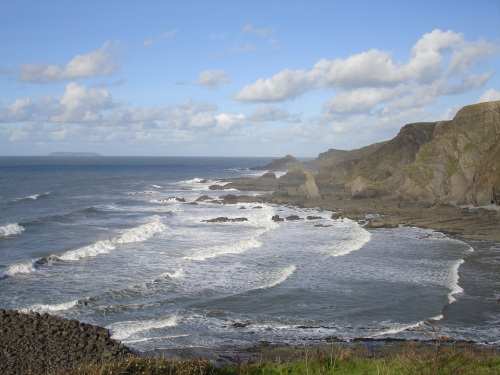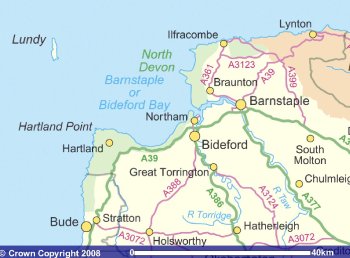Thomas Benson emerged as the leading merchant trader out of the North Devon port of Bideford after inheriting the family fortune in 1743 at the age of 37. Despite the onset of naval warfare between England and Spain, his vessels transported large quantities of tobacco from the colonies of Virginia and Maryland, exporting locally made woollen goods in return, and his fishing vessels sailed to the Newfoundland cod banks each year. In 1744 France joined the war against England as an ally of Spain, and this prompted Benson to fit out one of his vessels as a man-of-war with which he engaged the expanded enemy fleet as a privateer with some notable successes.
To further strengthen his grip over North Devon, and to facilitate the procurement of lucrative government contracts, Benson decided to enter politics and joined the governing Whig party which had by this time awarded him the prestigious title of High Sheriff of Devon, an office he held until 1749. After presenting the Corporation of Barnstaple with a magnificent silver punch bowl, he was duly elected unopposed as MP for Barnstaple in 1747.
His power-base in the region had become so entrenched that he began to believe he was above the law. But after his first serious brush with the Customs authorities over unpaid tobacco import duties, he became entangled in a web of deception involving breach of contract, smuggling, tax evasion, and finally a bold insurance fraud that was to lead to his undoing[note 1]. When this last scam was exposed Benson ignominiously took flight in self-imposed exile, leaving Captain Lancey, the master of his vessel the Nightingale, to face criminal charges on which he was found guilty and duly hanged.

The backdrop to Benson's devious schemes was visible on a clear day from his spacious family residence on the North Devon coast as a small outcrop on the horizon: Lundy Island.
This enchanting isle is seen in the distance on the left of the image shown above. On the right in the middle distance is Hartland Point, the mainland location closest to Lundy. The Bensons lived in Northam, some 13 miles to the east of Hartland Point.
The scene above was encapsulated in verse by William Wilsey Martin[4]:
The story of the the rise and fall of Thomas Benson reads like a parable of the corruptibility of a man driven by greed and a hunger for power. A more charitable view of Benson's wrongdoings is given by Stanley Thomas in his engaging and thoroughly researched book, The Nightingale Scandal, which examines in some depth the events surrounding his fall from grace. In the concluding section, the author reasons that Benson was very much a man of his time; in a period when corruption was endemic it was common for powerful individuals to consider fraudulent schemes as good business practice, and taken in the round Benson had done much to benefit the population of North Devon.
The following sections of this two-part feature explore Benson's story in greater detail.
Until Elizabethan times, Barnstaple on the Taw Estuary was the largest and most important maritime settlement in North Devon. From 1585, when Sir Richard Grenville brought English settlers to establish a colony on Roanoke Island off the coast of what is now North Carolina, Bideford at the mouth of the River Torridge grew rapidly and soon became the principal Devonshire port for trade with the American colonies. It continued to prosper for another two hundred years until these colonies achieved their independence.
[Map image produced from the Ordnance Survey Get-a-map service. Image reproduced with kind permission of Ordnance Survey and Ordnance Survey of Northern Ireland.]


A few miles to the north of Bideford where the Taw and Torridge meet and flow together over the bar out to the sea lies the small fishing village of Appledore (part of Northam) where Squire John Benson, a prosperous Bideford merchant, lived with his family in Knapp House built on a hill overlooking the estuary. This is where his third son, Thomas, was born in 1707.
In the Autumn of 1747, Benson, now age forty, was sworn in as the newly elected MP for Barnstaple. One of the first bills to come before the house was legislation to prohibit the insurance of French ships and their cargoes. Whether or not Benson took part in the debate, it is quite likely that it provided the inspiration for his subsequent actions and eventual downfall.
Benson had powerful political friends in Lord Carteret, Secretary of State, and his cousin, Lord Gower, the Lord Privy seal. Both owned estates in North Devon inherited from their family, the Grenvilles. With the war against France drawing to a close, Benson was keen to expand his trading with the colonies. With the help of these allies in government, he was able to secure a contract for shipping convicts to Maryland and Virginia which would subsidise the cost of the outward journeys of his regular trade route.
As far as Benson was concerned, the jewel in the crown in the estates of these noble lords was Lundy Island, and a year after the convict transportation contract had been signed, he entered into an agreement to lease the island from them at a rent of £60 per annum.
The island was uninhabited at the time, with the few houses still standing falling into disrepair, so one might well wonder what Benson could hope to achieve from such a transaction. Always on the make, Thomas had devised a cunning plan to use Lundy for financial gain: on the one hand he would offload his imported tobacco on the island and conceal it there to avoid paying the hefty import duties - smuggling, in the eyes of the Customs - and secondly, rather than transporting all the convicts to America as required by his contract, he would carry some them no further than Lundy where they would remain in bondage and be set to work on various schemes to improve the island. Meanwhile Benson would pocket the fees for shipping them to the colonies.

This cavern on Lundy came to be known as Benson's Cave, the assumption being that he had used his convict slave labour to excavate it for the purpose of storing smuggled merchandise. Subsequent excavation of its interior found graffiti on the walls dating from 1726, so it is more likely that the cave was tunnelled out during the tenancy of Richard Scores, the previous occupier, who was charged with smuggling on Lundy in 1721. This description of the cave comes from the naturalist P H Gosse, writing of a visit to the island in The Home Friend magazine in 1853 [2, p485]:
In Benson's first brush with the authorities, the records of the Court of Exchequer for 1750 show that Benson together with two of his mariners owed duty to the Collector of Customs for Barnstaple for a consignment of British Plantation tobacco imported the year before. The duty together with penalties for late payment amounted to £922, a considerable sum at the time. It is believed that he unloaded this tobacco on Lundy and buried it in Benson's Cave.
In the summer of 1752, Benson organized a trip to Lundy for a number of guests who had been staying at Knapp. Included in this party were, Sir Thomas Gunson, Sheriff of Somerset, and Thomas Stafford, Benson's young nephew and a personal favourite of his, and an anonymous member of the group who kept a journal of the visit. This gives us a revealing first-hand glimpse of Benson's character, and what life was like for his men and his enslaved convicts. They sailed on a Monday morning in a vessel bound for Wales which dropped them off at the Lundy Roads[note 2] from where they were taken ashore in a small boat.

Benson's quoted justification for keeping the deportees on Lundy was somewhat disingenuous as by so doing he was in breach of his contract to deliver these convicts to Virginia or Maryland, for which he no doubt claimed the full transportation fees. This was not quite as straightforward as it might seem. The terms of the contract required Benson to deposit a bond which could only be recovered by presenting a signed receipt confirming delivery of the convicts at their destination, with a £30 fine if it were not completed within three months.
Myrtle Ternstrom suggests[1, note to p28] two ruses he could have adopted, either of which would have enabled him to redeem the bond:
The wall that the convicts were pressed into building was the Quarter Wall that separates the more fertile southern sector of the island from the more rugged part to the north. Benson's plan was to cultivate the land to the south of the wall, constraining the wild goats and deer to roam on the other side. What remains of the Quarry Cottages that were built by the Lundy Granite Company in the 1860s to house the most senior workers of the company are situated on the north side of the Quarter Wall.

By the end of the week, Benson and his guests had returned to Appledore. Three or four days later the brigantine Nightingale, which they had seen lying off the quay at the time of their departure, set sail for Virginia with convicts on board. This was the start of a risky venture that Benson had planned meticulously. Having heavily insured the aging ship and its contents, the cargo was to be off-loaded on Lundy before scuttling the vessel some way further out to sea. The crew would then sign affidavits describing the sinking as a natural disaster, allowing a full insurance claim to be made. The outcome of this fateful journey and its ramifications for Benson and the crew is revealed in the second part of this feature.